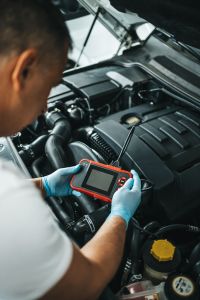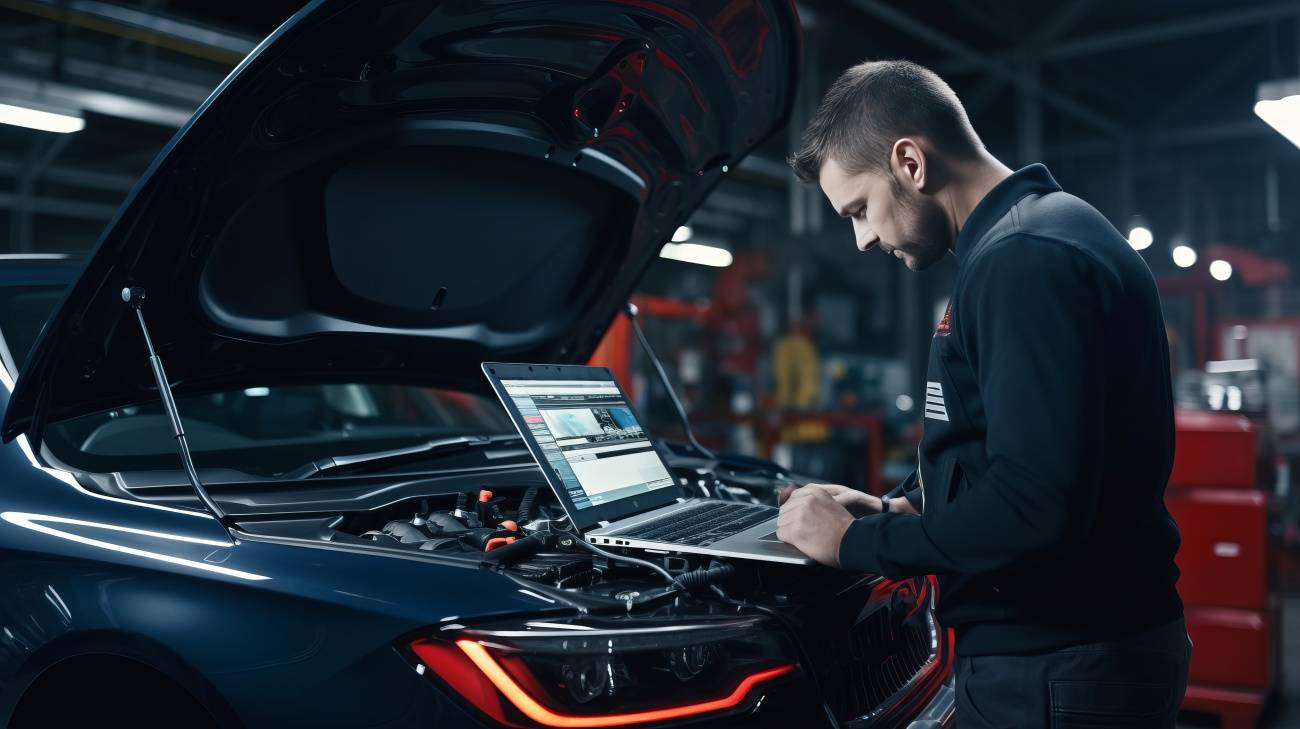For decades, the European automotive industry was the mainstay of the economy. With its innovative strength, design and engineering skills, it created millions of jobs and set standards worldwide. Today, it is at a critical turning point.
Increasing global competition, the relocation of production to Asia, the rise of electromobility and software-based technologies are fundamentally changing the automotive industry in Europe. In addition, stricter environmental regulations are increasing the pressure to adapt. In this context, a crucial question arises: how can the European automotive industry respond to changing market requirements and cost structures in order to secure its future viability? This article highlights the most important trends shaping the transformation of the automotive industry, outlines the resulting fields of action and finally shows what opportunities are opening up through negotiations and strategic cooperation.
Key trends in the automotive industry
Relocation of production to Asia
Europe is losing its traditional supremacy in automotive production. Countries such as Germany, France, Spain and Italy can look back on a long history of technical pioneering achievements, from the first combustion engines to leading development and manufacturing expertise. Today, however, many manufacturers are relocating their capacity to Asian countries, driven by lower labor costs, generous government subsidy programs and growing local demand.
- Cost structure: It is often cheaper to set up manufacturing sites in China and other Asian economies, particularly due to lower wages and attractive investment incentives.
- Growing sales market: Markets such as China now have a large and rapidly growing middle class that is demanding both traditional and electric vehicles, creating a self-sustaining cycle of growth.
Implications for Europe
Production relocations abroad are putting European plants under increasing pressure. Plants that do not realign themselves technologically in good time or do not offer competitive cost structures risk underutilization or even closure. This development has not only economic but also considerable social and political implications, as governments and trade unions are increasingly concerned about preserving jobs and local production capacities.
Electrification and e-mobility
Parallel to the geographical shift, an equally profound technological change is taking place: the electrification of the automobile. Almost all global manufacturers are investing heavily in the development of electric and hybrid vehicles in order to meet emissions targets and cater to changing consumer preferences.
- Emissions targets: European directives and national programs are increasing the pressure to reduce emissions from conventional combustion engines and accelerate the introduction of electric drives.
- Battery technology: The competition for more efficient, cost-effective and sustainable batteries is gaining momentum. In addition to efficiency and costs, securing strategically important raw materials such as lithium and cobalt also play a key role. Advances in battery technology have a significant impact on the price and range of vehicles - both decisive criteria for broad market acceptance.
- New forms of cooperation ('co-opetition'): Start-ups specializing in battery and software technology are emerging as both serious competitors and potential partners for established manufacturers. Strategic investments or partnerships can benefit both sides: For traditional OEMs, they drive technological innovation, and for start-ups, they provide access to production capacity and market structures that help with scaling.
Implications for car manufacturers
Electrification is no longer just a regulatory obligation, but a decisive competitive factor. Manufacturers who do not consistently drive forward their e-strategies risk losing relevance both in the face of new market players and in public perception. Successful transformation requires stable battery supply chains, the expansion of the charging infrastructure and differentiated positioning through technology and brand management.
Digitalization and software-defined vehicles
Another fundamental trend in the automotive industry is the digital revolution: cars are increasingly becoming 'computers on wheels' - equipped with software-based functions, modern infotainment systems, comprehensive connectivity services and semi-autonomous driving functions.
- Connected vehicles: More and more models are offering functions such as wireless software updates ('over-the-air'), early maintenance recommendations ('predictive maintenance') or app-based vehicle control. The development of such systems requires specialized software skills and comprehensive cyber security measures.
- Assisted and autonomous driving: While fully autonomous vehicles (SAE Level 5) are still a dream of the future, semi-automated driving functions (e.g. lane departure warning, adaptive cruise control) are already standard today. Partnerships with technology companies as well as AI and data expertise are essential for continuous further development in these areas.
Consequences for the industry
Traditional mechanical expertise alone is no longer enough to remain competitive. Car manufacturers and suppliers must increasingly integrate software developers, data scientists and artificial intelligence specialists. The supplier industry, which has so far focused on mechanical components, could also be forced to expand its offerings in the direction of smart systems, sensor technology and algorithms in order to remain competitive in the long term.
Sustainability and ESG requirements
In parallel with electrification, the increasing focus on sustainability is also fundamentally changing the way car manufacturers operate. Environmental, social and governance (ESG) criteria are becoming key components of corporate strategies.
- Sustainable supply chains: Companies are no longer just being monitored critically with regard to the emissions of their vehicles, but are being held accountable along the entire value chain - from the extraction of raw materials to the recycling of batteries and vehicle components.
- Circular economy approaches: More and more manufacturers are adopting strategies that enable the reprocessing, reuse or recycling of vehicle parts. In some cases, vehicles are already designed in the design phase in such a way that they can be dismantled and recycled more easily - a decisive step towards waste avoidance.
- Social and governance factors: Working conditions, diversity, transparency and ethical business practices are increasingly coming into focus. Investors, business partners and consumers increasingly expect companies to assume social responsibility in addition to being purely profit-oriented.
Implications for industry leaders
Companies that convincingly integrate sustainability and ESG principles into their business model at an early stage secure brand value, investor confidence and their own long-term competitiveness. On the other hand, those who treat them merely as a compulsory exercise run the risk of losing touch with new market standards. From the establishment of transparent supply chains to the consistent implementation of circular economy models - the companies that are leading the way here are setting standards that will guide the industry in the future.
Challenges for European car manufacturers and suppliers
Changing personnel structures
One of the biggest challenges in the transformation process of the automotive industry lies in dealing with the social impact - especially the changes in the labor market.
- Job losses versus skills gaps: While production relocations to Asia and increasing automation are threatening traditional manufacturing jobs in Europe, there is also a significant demand for skilled workers in areas such as software development, battery technology and data analysis. This creates an urgent need for action to comprehensively retrain and upskill the workforce.
- Social and political pressure: Governments and trade unions react sensitively to potential mass redundancies, not least because they trigger public debate and risk reputational damage. Negotiations on early retirement schemes, training programs or regional transformation funds are therefore often at the heart of the discussions.
- Long-term talent development: Beyond the immediate cushioning of job losses, companies are required to actively shape the development of a sustainable talent pool. Cooperation with universities and vocational academies can produce programmes for electromobility and digitalization that are highly relevant for future qualification requirements.
Structural change in the supplier industry
The supplier industry forms the backbone of the European automotive industry - and at the same time is under immense pressure due to technological change.
- From mechanical to intelligent systems: Many traditional suppliers specializing in transmissions, engines or brake components must expand their portfolio to include electronics, sensor technology and software in order to remain competitive in the new market environment. Larger suppliers such as Continental or Bosch have already set up their own software units or acquired technological start-ups in order to strengthen their position in the areas of autonomous driving, connectivity or infotainment.
- Financing the transformation: Smaller suppliers in particular face the challenge of financing investments in research, development and production conversions - often under difficult conditions due to fluctuating production volumes as a result of relocations or declines in demand.
- Complexity of cooperations: Strategic alliances or mergers offer many suppliers an opportunity to pool resources and jointly expand technological expertise. However, such mergers also harbor risks, for example with regard to the integration of different corporate cultures or a fair distribution of development profits.
Funding gaps in research and development
The development of the next generation of vehicles - particularly in the area of electromobility and autonomous driving - requires enormous, long-term investment in research and development. Many European manufacturers and suppliers are facing considerable financial challenges.
- High costs, high risks: Battery technology alone requires continuous innovation to improve range, cost structure and safety standards. The Swedish company Northvolt has received over 15 billion dollars in investment commitments to produce the world's 'greenest' batteries and reduce Europe's dependence on Asian imports. However, implementation has failed so far: the parent company had to file for insolvency. The development of autonomous driving systems also ties up immense resources in the billions, often with uncertain market maturity.
- Competition for capital: European car manufacturers and suppliers are competing for investment with financially strong technology companies and up-and-coming Asian EV manufacturers. This international competition for financial resources is putting pressure on medium-sized companies in particular and is impacting margins and innovation cycles.
- Public versus private funding Government funding programs and subsidies can stimulate technological developments, but are often linked to conditions such as job guarantees or location requirements. The challenge is to ensure a balanced mix of public support and private capital in order to drive innovation even in times of economic uncertainty.
Opportunities and negotiation paths
Despite all the challenges, European car manufacturers still have significant options for action. How proactive they are - particularly in dealing with changes in the labor market, political conditions, new cooperation models and international, including Asian, partnerships - will have a lasting impact on their resilience.
The following section outlines possible paths and some key considerations that are likely to become more important in the coming years when it comes to negotiating with trade unions, governments and business partners - both within Europe and internationally.
Negotiations with workforces
 Job security and targeted preparation for new fields of activity are at the heart of many transformation processes. One promising approach is to systematically integrate qualification measures - for example for digital manufacturing, electromobility and software development - into collective bargaining. Anchoring them in collective agreements promotes the stability of the workforce and socially acceptable change. However, the success of such initiatives depends largely on transparent communication and a fair distribution of the financial burden between companies, the state and employees.
Job security and targeted preparation for new fields of activity are at the heart of many transformation processes. One promising approach is to systematically integrate qualification measures - for example for digital manufacturing, electromobility and software development - into collective bargaining. Anchoring them in collective agreements promotes the stability of the workforce and socially acceptable change. However, the success of such initiatives depends largely on transparent communication and a fair distribution of the financial burden between companies, the state and employees.
In addition, models such as staggered retirement arrangements or early exit programs can play a role in negotiations. Approaches such as these help to mitigate the negative effects of sudden mass redundancies and at the same time create new employment opportunities for younger or internally retrained employees. Key negotiating aspects here are the scope of the benefits offered, possible government support - for example in the form of regional training subsidies - and the long-term sustainability of such models in the course of the transition from traditional combustion engines to new technologies.
State funding policy and public programs
Political framework conditions have a significant influence on the scope for company transformations. Targeted funding programs, tax incentives or co-financing models can significantly accelerate investments in research and development - especially in strategic areas such as electromobility and autonomous driving. Such funding instruments are often linked to conditions, such as job guarantees or minimum quotas for local production. Negotiations on the type and scope of such conditions are therefore becoming more important, as on the one hand they are suitable for promoting innovation, while on the other they have a potentially restrictive effect in a changing economic environment.
In addition, public-private partnerships (PPPs) can serve as catalysts for critical infrastructure projects. Car manufacturers, research institutions and public authorities can work together to drive forward the expansion of charging station networks or create test corridors for autonomous driving. From a negotiation perspective, it is crucial for the success of such partnerships to agree on clearly defined mechanisms for the distribution of costs and profits and to agree on coordinated sustainability targets.
Partnerships and alliances
In view of the enormous dynamics of innovation
cross-industry and cross-value chain cooperation is becoming a key factor for Europe's automotive industry. In particular, smaller suppliers that want to switch to components for electromobility or connectivity solutions can accelerate product development by sharing research and development resources. However, the design of such collaborations requires careful negotiation on the use of development results, intellectual property rights and the sharing of investment risks. The distribution of profits should also be mutually agreed on the basis of clearly formulated business expectations.
In addition, alliances between technology companies and energy suppliers may increasingly be formed. The integration of 5G technologies and satellite communication into vehicle connectivity, the development of an integrated battery value chain and intelligent energy solutions for vehicle fleets could also be the subject of future negotiations. Such collaborations require not only technological interface expertise, but also clear agreements on investments, data sovereignty and long-term business models. Precisely because technologies and market conditions are developing rapidly, flexible, resilient partnership structures are crucial in order to jointly exploit opportunities and balance risks.
Cooperation with Asian partners: reaching balanced agreements
As production continues to relocate to Asia, cooperation with Asian companies is becoming more important. China in particular has mass production excellence and strong expertise in battery and semiconductor technologies. European companies, on the other hand, bring their strengths in design, engineering and brand management to the collaboration. Cooperative development projects offer synergy potential - be it in connection with platforms for electric vehicles, technology transfer or joint production facilities.
However, cultural differences, divergent regulatory frameworks and intellectual property issues require a high degree of sensitivity and careful preparation, especially in the early negotiation phase. Viable agreements inevitably require clear regulations on property rights, investment structures and performance reviews.
On the way to a sustainable future
The current challenges also present an opportunity for fundamental renewal. Principles of the circular economy - such as material recovery and recycling - can make a decisive contribution to the ecological and economic resilience of the automotive industry. In future, negotiations with suppliers and political decision-makers could increasingly focus on establishing closed material cycles and battery recycling.
The promotion of regional innovation clusters around research institutions and start-ups offers the opportunity to secure Europe's leading engineering expertise in the long term. If companies and trade unions reach viable agreements on skills transitions and governments target their resources towards advanced infrastructure and green technologies, Europe could maintain its position even in the face of increasingly intense global competition.
Through proactive and carefully structured negotiations at all relevant levels - with employee representatives, governments, industry networks and international partners - the European automotive industry can embark on a more stable and sustainable path into the future.
Time for the next gear
The European automotive industry is at a crossroads. Unprecedented changes - from the ongoing shift of production capacity to Asia to the growing demand for electrified and digitally connected vehicles - are challenging its industrial heritage. But as daunting as these upheavals may seem, they also present an opportunity for reinvention.
The forces that are reshaping the global market present operational, financial and social challenges. Existing structures are coming under pressure, but change does not mean inevitable decline. The negotiation paths outlined show ways in which companies, governments and employee representatives can master the complexity: through smart negotiations, new alliances and balanced cooperation.
Success will depend on the ability to develop flexible and innovative strategies based on shared responsibility. Initiatives such as joint research projects, public investment in charging infrastructure or cooperation between car manufacturers and energy suppliers could be exemplary models for reconciling market requirements and ecological goals. Such strategies will not eliminate all risks, but they are likely to create a more resilient basis for sustainable growth.
Looking ahead, Europe's opportunity lies in actively shaping change while preserving its strengths: high-quality manufacturing, deep-rooted engineering excellence and a growing commitment to sustainability. By embedding these values in negotiations - both within Europe and internationally - Europe's automotive industry can maintain its leadership in pioneering mobility technologies, even as the global center of power continues to shift. In this sense, today's challenges could ultimately act as a catalyst for a more stable, sustainable and socially responsible future.









